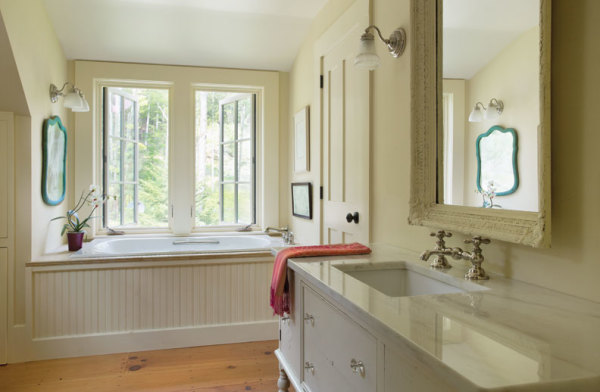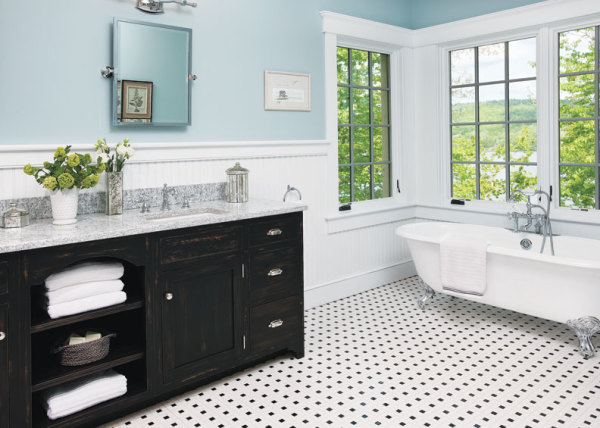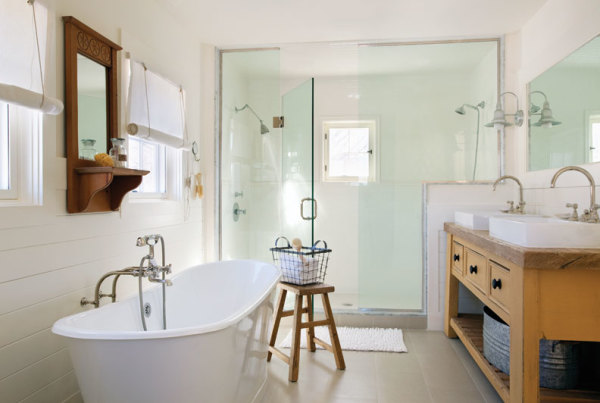Sandra Vitzthum designed this bath for a family in Vermont. The vanity is an old dresser, which Vitzthum transformed. (Photo: Eric Roth)
Since its inception, the bathroom has always been a modern space. The earliest American bathrooms date back to the mid-1800s and were improvements on privies and outhouses. Initially reserved for the wealthy, they were a luxury of space, materials, and innovation, evolving hand in hand with advancements in and the availability of indoor plumbing.
Today’s bathrooms are no longer limited by plumbing, but are still ruled by technologies relating to water and energy use and moisture-resistant materials. A bathroom’s ultimate design benefits from a dizzying array of potential features, many of which are demanding on natural resources.
Ensuring that this oft-used room is eco-friendly as well as stylish can have lasting ramifications on a household’s future energy, water/sewage, and construction/repair costs. Incorporating efficient components and locally sourced materials while harkening back to the principles of traditional craftsmanship are central to the sustainable cause.
Reimagining History
Vermont-based architect Sandra Vitzthum admits that the process of creating a traditionally styled bathroom leaves room for design freedom, particularly since a bathroom in a historic home might have been retrofitted at a later date and potentially remodeled one or more times later on. A home’s architectural style could predate established bathrooms entirely, requiring a creative approach to making new look old.
“I’m working on a 1700s Dutch Colonial, and there is no bathroom reference for that time period,” explains Vitzthum. “We opted for timeless elements like wood wainscoting, handmade encaustic tiles, raw brass fixtures, and vanities made from reclaimed furniture.
“When I’m trying to make a bathroom look older, I tend to use as much wood as possible,” she continues. “I also opt for simple wood floors.” Her other aging trick is to make the room appear utilitarian, in keeping with an area where aesthetics historically revolved around function.
A Green Approach
[caption]Opting for natural light is a great green alternative. Architect Gil Schafer introduced a sink and mirror in front of a window. (Photo: Jonathan Wallen for Gil Schafer’s The Great American House).
A Green Approach
As Vitzthum points out, many traditional design elements are inherently eco-friendly. Wood, whether used for floors, built-ins, or wainscoting, is a renewable resource that is long-lasting when properly finished with VOC-free paints and finishes. Reclaimed furniture, vanities, cupboards, sinks, tubs, and fixtures are no less than recycled materials and yet lend their own intriguing histories. And there’s no limit to the potential of inventive recycling: Vitzthum has even designed a slate shower using old schoolroom chalkboards.
Tiles can be made out of a range of recycled materials, from newspapers to glass; however, these options tend toward modern tastes, which is why Vitzthum recommends ceramic or encaustic tile for new-old projects. Ceramic tiles are inherently sustainable. They are made from natural and plentiful raw materials available in close proximity to factories. Plus, they last up to four times longer than other materials, including wood, cutting down on future remodeling waste.
There is no historic precedent for the expansive cabinetry prevalent in today’s homes. An early bathroom’s interior would have contained individual furniture pieces, such as washstands, armoires, and medicine cabinets. If newly constructed cabinets are preferred, consider custom-made units that mimic the appearance of freestanding furniture. Certified sustainable wood and VOC-free finishes together make for the most responsible cabinets possible.
Proper ventilation is key to assuring the longevity of building materials; it prevents mold and mildew as well as structural damage and rot. Operable windows coupled with a high-efficiency Energy Star exhaust fan are essential in the fight against moisture.
Water Conservation
When sourcing new toilets and fixtures that are traditionally styled, the greenest options are models with the WaterSense label. The EPA unveiled its WaterSense program in 2006 to help consumers save money and maintain high environmental standards without compromising performance. Certified products are at least 20 percent more efficient than other options on the market. For example, a WaterSense faucet outfitted with a WaterSense aerator can save a household approximately 11,000 gallons of water over the life of the faucet.
Design firm Zero Energy used low flow fixtures and reclaimed wood floors in this sustainable bath. (Photo: Eric Roth)
Toilets account for a hefty portion of indoor water use: nearly 30 percent, according to the EPA. WaterSense-labeled single-flush toilets use 1.28 gallons per flush (gpf) or less, versus the current federal standard of 1.6 gpf. Many WaterSense toilets are dual flush, with a full flush volume for solids (1.6 gpf) and reduced for liquids (1.1 gpf).
Another leading drain on water is the shower: Showering accounts for nearly 17 percent of residential indoor water use, up to nearly 40 gallons per day for the average family. WaterSense showerheads use no more than 2 gallons of water per minute (gpm), compared to standard heads using 2.5 gpm. A WaterSense showerhead saves not just water, but more specifically heated water, lowering a home’s overall energy consumption.
Blending modern features into a traditionally styled bathroom is challenging, but rewards the latest sustainable technologies. Overall, the bathroom’s storyline as a continually evolving space manages to prioritize both looks and comfort without sacrificing the environment.







